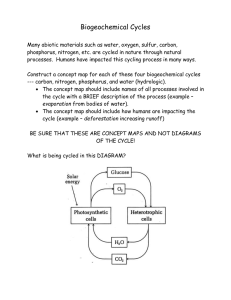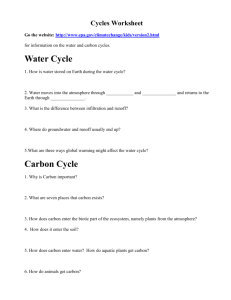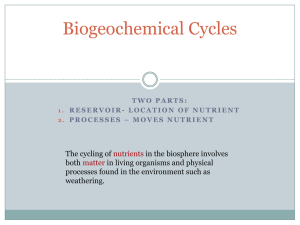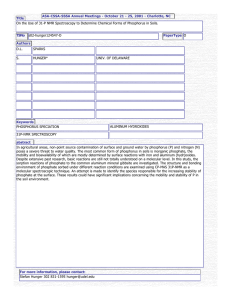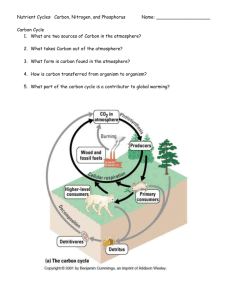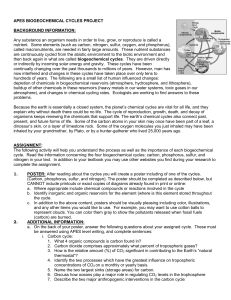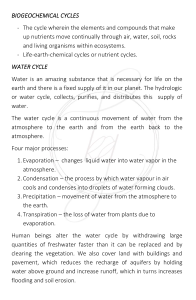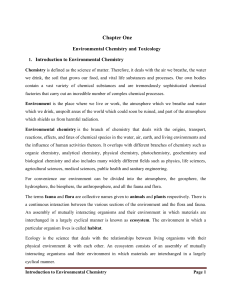biogeochemical cycle
advertisement
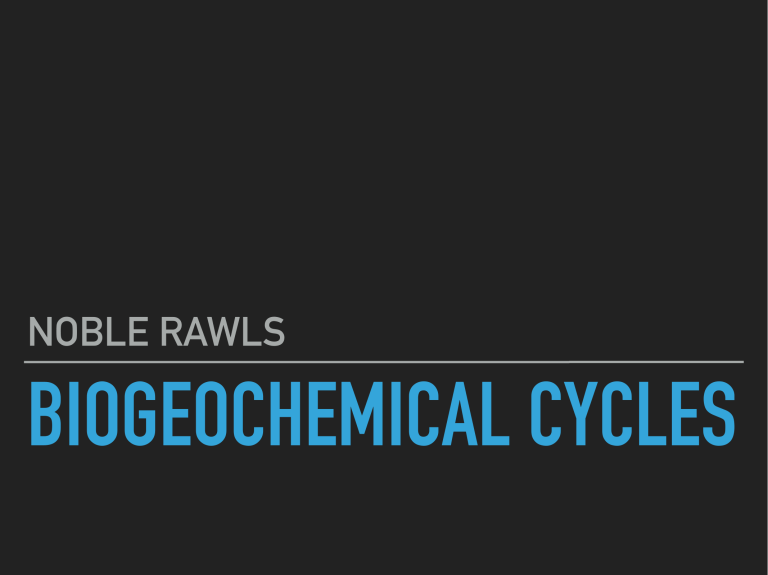
NOBLE RAWLS BIOGEOCHEMICAL CYCLES WHAT ARE BIOGEOCHEMICAL CYCLES? ▸ Biogeochemical Cycles are a variety of cycles that move elements and compounds through air, water, solids, and living organisms. It plays a very important part on our planet because with out it nothing could survive. HYDROLOGIC CYCLE ▸ This cycle helps purify, collect, and distribute the earths fixed water supply. The hydrologic cycle is very important because it provides water to plants, animals, and humans. Also it key in moving nutrients and pathogens in the ecosystem. ▸ The most water is found in the ocean; having 70% of the earth covered by the sea. ▸ Human Impact: Fist humans drain and fill wetlands with farms and urban development. Also humans withdraw water from rivers, lakes and other water sources faster then it can be replenished. HYDROLOGIC CYCLE ▸ Process: The sun provides energy. From that heat comes evaporation, then from the vapor it turns into droplets in the clouds. Gravity then makes it rain, snow, or sleet. CARBON CYCLE ▸ This cycle is a binding block for carbohydrates, fats, proteins, and DNA. There are different compounds of carbons that circulate through the biosphere, atmosphere, and parts of the geosphere and hydrosphere. The carbon really important because that is what we are made out of. ▸ The largest amount of carbon is found in Terrestrial Rocks. ▸ Humans are altering the Carbon Cycle by adding very large amounts of carbon dioxide to the atmosphere. CARBON CYLE ▸ Process: Carbon diffuses between the atmosphere and the ocean. Then the carbon enters marine food webs and marine species carry out photosynthesis, then put into the sea water when the carryout aerobic reparation. NITROGEN CYCLE ▸ Nitrogen is a crucial component of proteins, many vitamins, and DNA. It becomes usable by producers only in the form of compounds such as ammonia and ammonium ions. ▸ The most Nitrogen is found in the atmosphere. ▸ Human Impact: Humans will burn gasoline and other fuels in massive amounts, which can be converted into acid rain. and kill lots of life in forest and lakes. Humans also hurt the ecosystem by adding excess nitrates that contaminate bodies of water through agricultural runoff of fertilizers, animal manure, and discharges from municipal sewage treatment systems. NITROGEN CYCLE ▸ Process: Nitrogen Fixation happens first. The Nitrification happens next and that is when ammonia converts to nitrate ions, therefor, the plant is able to take in nutrients. Then comes Ammonification and after that comes Denitrification. PHOSPHORUS CYCLE ▸ Phosphorus is an element that is essential for living things and provides energy for life processes. The phosphorus cycle moves phosphorus through water, Earth’s crust, and living organisms. ▸ Most commonly found in the environment as phosphates. ▸ Human Impact: Mining large amounts of phosphate hurts the cycle. Also By clearing tropical forests, humans expose the topsoil to greater erosion, which reduces phosphate levels in the soil. PHOSPHORUS CYCLE ▸ Process: Rain cause rocks to release phosphate ions and phosphate is then distributed in soils and water. Plants then consume the phosphate. Then animals consume the plants. But when the animal dies it decays and phosphate is returned to the soil.
